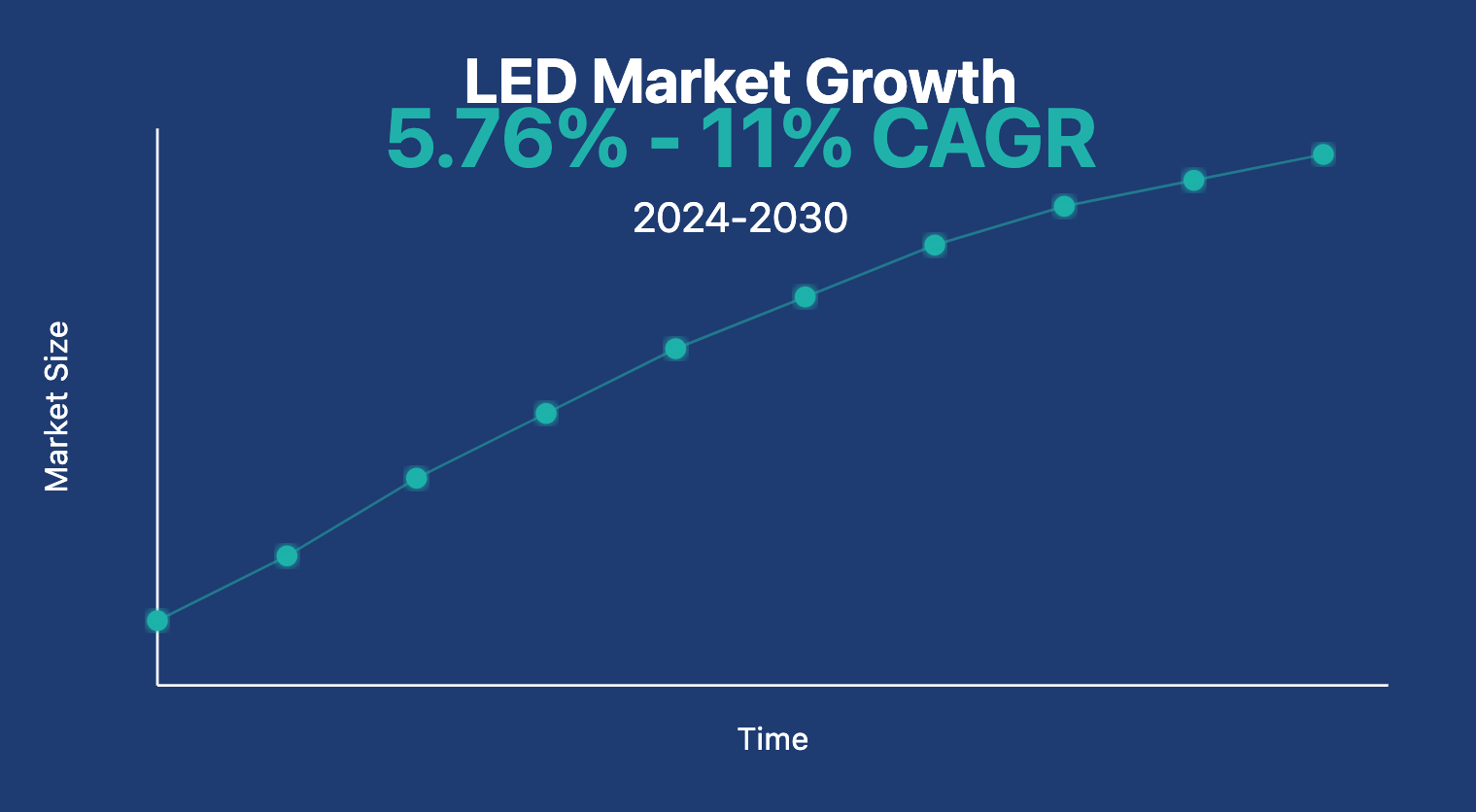As businesses and consumers increasingly prioritize energy efficiency and cost-effective lighting solutions, understanding the growth rate of the LED lighting market becomes crucial for decision-making. Whether you're an investor, manufacturer, or simply curious about industry trends, you might be wondering: What is the LED lighting market CAGR?
The LED lighting market CAGR is projected at anywhere from 5.76% to 11% from 2024 to 2030, indicating strong growth in this sector over the next few years.1
While this brief answer provides a general idea of the market's growth trajectory, it's important to delve deeper into the factors driving this growth and how it may vary across different regions and market segments. Continue reading to gain a more comprehensive understanding of the LED lighting market's potential and its impact on various industries.
Why Are Growth Projections So Divergent?
While all CAGR projections are positive indicating strong growth, the gap between projections is surprisingly vast. For instance, Mordor Intelligence estimates a modest CAGR of 5.76% from 2024 to 2030, while OLAMLED, Grand View Research, and SkyQuest report a higher CAGR of 11% for similar periods. MarketsandMarkets falls in between with a projected CAGR of 8.5% from 2024 to 2029.
These discrepancies can be attributed to differences in geographical scope, market segmentation, research methodologies, and data sources used by each firm. Despite the variations, all projections indicate a positive growth trajectory for the LED lighting market, driven by factors such as increasing adoption, technological advancements, and the push for energy efficiency across various sectors.
How Does The LED Lighting Market Vary Across Different Regions?
CAGR Projections for LED Lighting Market by Region
The global LED lighting market is experiencing strong growth, but this growth varies significantly across different regions. The Asia-Pacific region is projected to have the highest CAGR at 14.6% according to a report by Lighted Magazine. This rapid growth is driven by factors such as increasing urbanization, government initiatives promoting energy-efficient lighting, and rising consumer awareness about the benefits of LED technology in countries like China and India.
Europe is also expected to see robust growth, with a projected CAGR of 11.7% based on the same Lighted Magazine report. The region's early adoption of LED technology and continued efforts to replace older lighting systems and implement smart lighting solutions contribute to this strong growth trajectory.
North America, while still seeing positive growth, has a comparatively lower projected CAGR of 8.8% according to a report by Grand View Research. As an early adopter of LED technology, the region's growth is more steady as it continues to replace existing lighting infrastructure and integrate LED solutions in various sectors.
Emerging markets in the Middle East and Africa are also showing increasing adoption of LED lighting. With abundant sunlight and a growing focus on sustainable development, these regions are turning to solar-powered LED lighting solutions for both urban and rural areas, further contributing to the overall growth of the global LED lighting market.
What Challenges Does The LED Lighting Market Face?
Initial Cost
Higher upfront costs compared to traditional lighting options
Rapid Technological Changes
Fear of product obsolescence due to fast-paced innovations
Quality Control
Influx of low-quality products affecting consumer trust
Despite its impressive growth trajectory, the LED lighting market isn't without its challenges. One significant hurdle is the initial cost of LED lighting systems. While prices have decreased considerably over the years, LED lights still tend to be more expensive upfront compared to traditional lighting options. This can be a barrier to adoption, particularly in price-sensitive markets or for large-scale projects.
Another challenge is the rapid pace of technological advancement in the LED industry. While innovation drives progress, it can also lead to product obsolescence. Businesses and consumers may hesitate to invest in current LED technology, fearing that it might become outdated quickly. This fear of obsolescence can slow down adoption rates and market growth.
Quality control is another issue facing the LED lighting market. As demand has increased, so has the number of manufacturers entering the market. While competition can be beneficial, it has also led to a flood of low-quality products. These subpar LEDs can underperform or fail prematurely, potentially damaging consumer trust in LED technology as a whole.
Lastly, the LED lighting market faces challenges related to recycling and disposal. LED lights contain electronic components and small amounts of hazardous materials that require proper handling at the end of their life cycle. As the first generation of LED lights reaches the end of its lifespan, developing efficient and environmentally friendly recycling processes becomes increasingly important.
What Factors Are Driving The LED Lighting Market Growth?
The impressive CAGR of the LED lighting market is not happening in a vacuum. Several key factors are contributing to this robust growth. First and foremost is the increasing global focus on energy efficiency and sustainability. As governments and organizations worldwide implement stricter energy regulations, LED lighting has become a go-to solution due to its low energy consumption and long lifespan.
Another significant driver is the rapid advancement in LED technology. Manufacturers are continuously improving the efficiency, brightness, and color quality of LED lights, making them more attractive for a wider range of applications. This technological progress has also led to a decrease in production costs, making LED lighting more affordable for consumers and businesses alike.
Urbanization and smart city initiatives are also playing a crucial role in boosting the LED lighting market. As cities grow and modernize, there's an increasing demand for efficient, controllable lighting systems for streets, buildings, and public spaces. LED lighting, with its compatibility with smart control systems, is perfectly positioned to meet these needs.
What Are The Future Trends In The LED Lighting Market?
Looking ahead, several exciting trends are shaping the future of the LED lighting market. One of the most promising is the integration of LED lighting with Internet of Things (IoT) technology. This combination is paving the way for smart lighting systems that can adjust based on occupancy, time of day, and even individual user preferences, further enhancing energy efficiency and user comfort.
Another emerging trend is the use of LED lighting for non-illumination purposes. For example, Li-Fi (Light Fidelity) technology uses LED lights to transmit data, potentially offering an alternative or complement to Wi-Fi in certain applications. Additionally, horticultural LED lighting is gaining traction, as it allows for precise control of light spectra to optimize plant growth in indoor farming environments.
Lastly, there's a growing focus on human-centric lighting. This approach uses LED technology to create lighting environments that support human health, well-being, and productivity by mimicking natural light patterns. As research in this area progresses, we can expect to see more widespread adoption of human-centric lighting in workplaces, healthcare facilities, and even homes.
How Is LED Lighting Impacting Various Industries?
The growth of the LED lighting market is having far-reaching effects across numerous industries. In the retail sector, LED lighting is revolutionizing store design and product displays. The ability to adjust color temperature and intensity allows retailers to create more appealing environments and highlight products more effectively, potentially boosting sales.
In the automotive industry, LED lighting is becoming standard not just for headlights and taillights, but also for interior lighting. LEDs' durability, energy efficiency, and design flexibility make them ideal for this application. Moreover, advanced LED systems are enabling new safety features like adaptive headlights that adjust to driving conditions.
The healthcare industry is also benefiting from advancements in LED technology. Beyond general illumination, specialized LED lights are being used for phototherapy treatments, surgical lighting, and even sterilization through UV LEDs. The ability to control light spectra precisely is opening up new possibilities for medical applications.
In agriculture, LED lighting is transforming indoor farming practices. By providing tailored light spectra, LED grow lights can optimize plant growth, potentially increasing yields and allowing for year-round production of certain crops. This technology is particularly valuable in urban farming and vertical agriculture settings.
The entertainment industry, too, has embraced LED lighting. From stage lighting to large-scale displays, LEDs offer unparalleled flexibility in creating dynamic visual experiences. Their low heat output and energy efficiency make them ideal for prolonged use in theaters, concert venues, and theme parks.
As LED technology continues to advance and find new applications, its impact across these and other industries is likely to grow, further driving the expansion of the LED lighting market.


